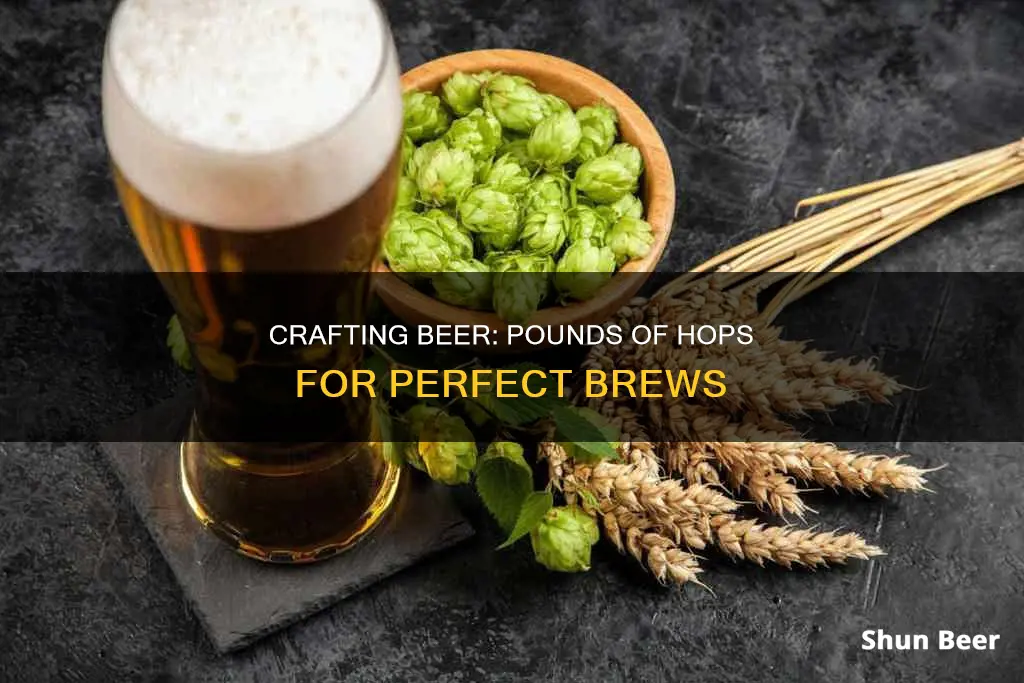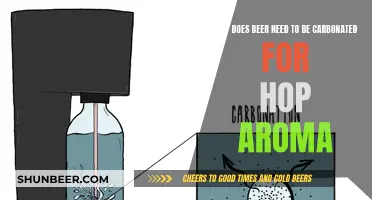
Brewing beer is a complex process that requires a precise balance of ingredients, including hops. Hops are a precious and increasingly expensive commodity, so it's important to know how much to use to save money and enhance the quality of your beer. The amount of hops used depends on the style of beer being brewed and the desired level of bitterness and aroma. For example, an American Amber Ale typically has between 20 and 40 International Bitterness Units (IBUs), and the amount of hops added can be adjusted to reach this target. Different methods and equations, such as Rager, Tinseth, and Garetz, are used to estimate the utilization percentage and IBUs, helping brewers determine the right amount of hops to use.
What You'll Learn

Home Bitterness Units (HBUs)
Homebrew Bitterness Units (HBUs) are a simple way to assess how much hops you need to achieve a specific level of bitterness in your beer. The number of HBUs in a beer is calculated by multiplying the number of ounces of hops used by the alpha acid value of the hops. Alpha acids are the active ingredient that provides the bitterness.
For example, if a 5-gallon beer recipe calls for 2.5 ounces of hops with a 4% alpha acid content, the HBU would be 10. Thus, if another recipe requires 10 HBUs but you only have hops with a 4% alpha acid content, you would need 2.5 ounces of hops.
While HBUs are easy to calculate, they are not very accurate. The actual bitterness of a beer depends on several factors, including the efficiency of the boil in converting alpha acids to iso-alpha acids, the time of hop addition, the size of the batch, the size of the boil, the original gravity, and the boil time for the hops.
A more accurate method to determine beer bitterness is the International Bitterness Unit (IBU). One IBU is measured directly using a formula with a spectrophotometer and solvent extraction. Professionals and advanced brewers use IBU estimates to design their beers.
To calculate IBUs for a single hop addition, you can use the following simplified equation:
IBUs = U% * (ALPHA% * W_OZ * 0.7489) / (V_Gal)
Where:
- U% is the hop utilization percentage, which varies by boil time, wort gravity, and other factors
- ALPHA% is the percent alpha for the hop variety
- W_OZ is the hop weight in ounces
- V_GAL is the volume of hops in gallons
For multiple hop additions, you need to add up the IBUs from each addition.
IBUs provide a more precise measurement of bitterness, allowing brewers to fine-tune their recipes and create world-class beers.
Hops' Preservative Powers: Keeping Beer Fresh
You may want to see also

International Bitterness Unit (IBU)
International Bitterness Units (IBU) are a way to measure how bitter a beer is. While the scale is useful, it does not determine the perceived bitterness of the taste of the beer. For example, a beer with a higher IBU does not necessarily taste as bitter as a beer with a lower IBU. This is because beer is about the balance of ingredients and taste. A strong Amber ale rated at 60 IBUs, for instance, may not taste as bitter as a 55-IBU Pale Ale because the Amber ale's stronger malt character balances the overall bitterness.
The IBU scale measures the number of bittering compounds, specifically isomerized and oxidized alpha acids, polyphenols, and a few other bittering chemicals that make your beer taste bitter. The IBU correlates well with the sensory bitterness of beer, which is why brewers use it. Almost all beers will have a measured IBU between five (very low bitterness) and 120 (very high bitterness). Most beers fall within a narrower range of 15 to 80 IBUs.
IBUs were introduced in the early 20th century as a way to quantify and assess how bitter a beer is. Commercial brewers track IBU to help them maintain consistent flavour from batch to batch. The IBU measures the parts per million (PPM) of isohumulone, the chemical that results when alpha acids from hops are heated during the boil. Higher concentrations of isohumulone theoretically make for more bitter beers, but other factors also affect the flavour.
Beers with an IBU of less than 20 display little to no hops presence. Beers with an IBU of 20 to 45, the most common range, have a mild to pronounced hops presence. Beers with an IBU of greater than 45 can taste quite bitter. However, the presence of malt, fruit, honey, or other ingredients can affect the perception of bitterness, adding a smooth sweetness or crisp quality to the beer.
Stout Beers: Hops, Their Presence and Purpose
You may want to see also

Hop Utilization
Several factors influence hop utilization, and understanding these variables is essential for brewers to achieve the desired bitterness levels in their beers. One key factor is the form of hops used; pelletized hops generally provide better utilization than whole cones due to their greater surface area. The time of the hop boil also plays a significant role, with longer and more vigorous boiling promoting higher utilization. Additionally, the gravity of the wort, the kettle configuration, and the placement of the heat source can impact the rolling action during the boil, thereby affecting utilization.
The time of the hot stand after the boil and before cooling, as well as agitation after the boil, are other variables that influence hop utilization. Agitation techniques like whirlpooling can increase the percentage of bitterness extracted from the hops. It's important to note that substantial alpha acids are lost during fermentation, packaging, and aging, which can further impact the overall bitterness of the final beer.
To estimate bitterness levels during brewing, brewers commonly use one of three major hop utilization equations: Tinseth, Garetz, or Rager. These equations estimate bitterness as measured in International Bitterness Units (IBUs), where one IBU represents approximately one milligram per liter of isomerized alpha acids in the wort. While these equations provide estimates, the actual bitterness of a beer can only be determined through direct measurement using specialized equipment and techniques.
Crafting the Perfect Rolling Hop Beer: A Brewer's Guide
You may want to see also

Hop weight
The weight of hops added to beer depends on the type of beer being brewed, the desired aroma and bitterness, and the hopping schedule. For example, the weight of hops added for bittering, flavour, and aroma will differ.
For a 5-gallon (19-L) batch of American pale ale, the following hop weights are recommended:
- Dry hops: 0.5–1.5 oz. (14–42 g)
- Boiled 5–0 minutes: 0.5–1.0 oz. (14–28 g)
- Combined total: 1.5–2.25 oz. (42–64 g)
- Boiled 25–6 minutes: 0–1.25 oz. (0–35 g)
- Boiled 90–60 minutes: 30–45 IBUs
For an IPA, the hop weights are slightly higher:
- Dry hops: 1.5–2.5 oz. (42–71 g)
- Boiled 5–0 minutes: 1.0–2.0 oz. (28–57 g)
- Combined total: 2.75–3.5 oz. (78–99 g)
- Boiled 25–6 minutes: 0–1.5 oz. (0–42 g)
- Boiled 90–60 minutes: 40–70 IBUs
For a double IPA, the hop weights are even higher:
- Dry hops: 2.0–5.0 oz. (57–140 g)
- Boiled 5–0 minutes: 1.5–5.0 oz. (42–140 g)
- Combined total: 3.5–7.0 oz. (99–200 g)
- Boiled 25–6 minutes: 0–2.5 oz. (0–71 g)
- Boiled 90–60 minutes: 60–120 IBUs
It's important to note that these are just guidelines, and the actual hop weights used may vary depending on the specific recipe and brewing techniques. The weight of hops can also be calculated using the International Bitterness Unit (IBU) formula, which takes into account factors such as hop utilization, alpha acid content, weight, and volume.
Dry Hop Beer: Aging and Its Effects
You may want to see also

Hop schedule
A hop schedule is a crucial aspect of brewing beer, as it determines the bitterness, flavour, and aroma of the final product. Hops are typically added in three stages during the boil: bittering, flavouring, and aroma. However, the number of hop additions can vary from one to up to five or six, depending on the desired characteristics of the beer.
Bittering Hops
Bittering hops are added at the beginning of the boil, once the wort has been collected in the kettle or after the malt extract has been added. They are usually boiled for around 60 minutes but can be as little as 30 minutes. The long boil time helps to release the bittering potential of the hops, balancing the sweetness of the malt. Additionally, boiling the hops acts as a natural preservative, extending the shelf life of the beer.
Flavouring Hops
Flavouring hops are added with approximately 15 to 30 minutes remaining in the boil. During this time frame, the bitterness of the hops is subdued, while their crisp, hoppy flavour is accentuated. This addition contributes to the overall flavour profile of the beer without overwhelming bitterness.
Aroma Hops
Aroma hops are added during the last 5 minutes of the boil or at flame-out, when the kettle is removed from the heat. The hop oils responsible for aroma are highly volatile and will dissipate if boiled for too long. Adding aroma hops at the end of the boil maximises the aromatic qualities of the hops, providing a pleasant scent to the beer.
It's important to note that the timing of hop additions is crucial. When following a recipe, pay close attention to whether the timing is indicated from the start of the boil or the time left in the boil. This distinction can significantly impact the bitterness and overall character of the beer.
Additionally, it's worth mentioning that any type of hop can be used for any addition. For example, Cascade hops can be utilised as bittering, flavouring, or aroma hops. Using the same hop variety for multiple additions can add complexity to the beer.
Belgian Beer and Hops: A Complex Relationship
You may want to see also
Frequently asked questions
It depends on the type of beer being brewed. For a 5-gallon batch of American Pale Ale, you would need between 0.5 and 1.5 oz of hops, which means you could make between 16 and 32 gallons of beer from a pound of hops. For an IPA, you would need between 1.5 and 2.5 oz of hops per 5 gallons, so a pound of hops would be enough for 8 to 16 gallons. For a double IPA, you would need between 2 and 5 oz of hops per 5 gallons, so a pound of hops would be enough for 5 to 10 gallons.
The amount of hops required to brew a beer depends on several factors, including the style of beer, the desired bitterness level, the alpha acid content of the hops, the boil time, the boil size, and the gravity of the wort.
To calculate the number of beers you can make from a pound of hops, you need to know the weight of hops required for your specific recipe and the weight of the hops you have. You can then divide the weight of hops you have by the weight of hops required per beer to determine the number of beers you can make.







